What Meat Used for Beef Bulgogi
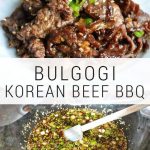
Bulgogi is the most popular Korean Grilled BBQ Beef dish that is made from marinated thin slices of beef that's traditionally grilled over an open flame. Flavors of sweet, salty and garlicky soy sauce with a hint of sesame oil has been my go-to family recipe for 27 years!!
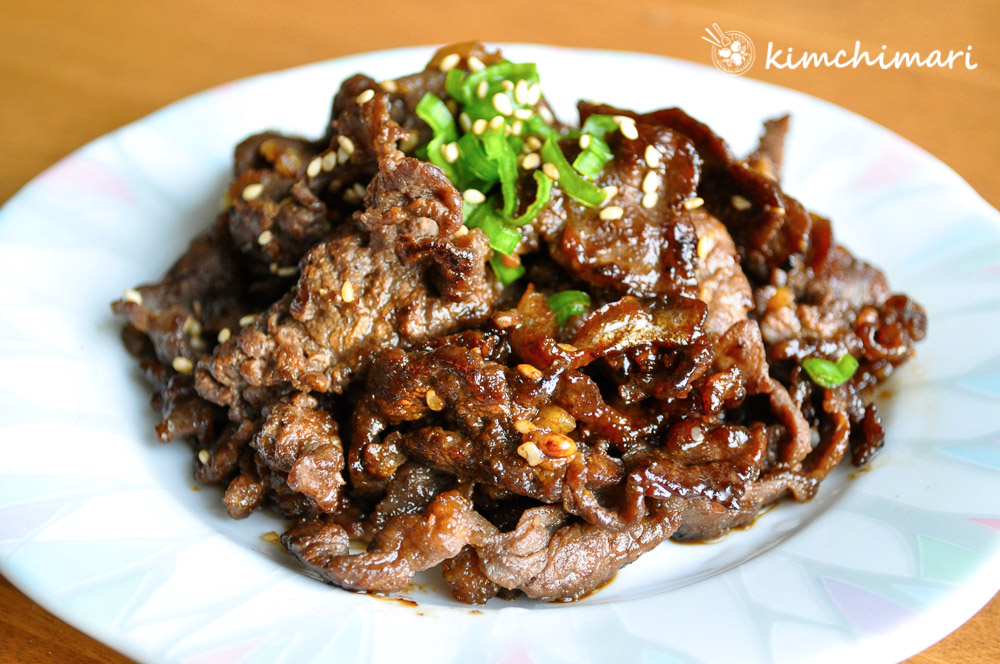
Bulgogi which literally means 'fire meat' is an amazing Korean BBQ grilled beef dish that will make anyone a fan of Korean food once you taste it. Actually, this is the very first recipe that I posted when I started my blog in 2010 and as I said in the title, I have been using this authentic recipe ever since and even longer – for 27 years which is how long I have been married. 😍
So my Authentic Bulgogi recipe has truly stood the test of time.
About Bulgogi
Bulgogi has origins dating back thousands of years to the kingdom of Goguryeo (고구려 37 BC – 668 AD) which was in the form of beef grilled on skewers. Later in the 1800's, with the introduction of metal grates, Koreans started to marinate thin cuts of beef and then grill on top of these gridirons. These were called Neobiahni Gui 너비아니 구이 which actually used thicker slices of beef than what is used today.
My most delicious memory goes way back to the days when my father took the whole family out to dinner at his favorite restaurant – Wooraeok 우래옥. You see the original owner of Wooraeok was a good friend of my father since they both fled North Korea during the Korean War in the '50s.
Wooraeok still exists today and has sister restaurants in Washington DC and New York. They still cook the beef on this type of pan and my dad used to add rice and cracked an egg to the juice that accumulated around the rim. And OH MY…you will get a wonderful juk there.. I can still remember how good it tasted and I thought my dad was a genius!!
BTW, in this post, I offer several substitutions and variations that you can try based on my recipe. They will ALL taste good but I think it is good to have options in case you don't have all the ingredients or if you prefer one ingredient over another.
What is Bulgogi Sauce made with? Do you have to use Asian pear?
Traditionally the marinade sauce is made from soy sauce (jin ganjang), mirin or cooking rice wine, Asian pear, garlic, sugar and/or honey, sesame oil, sesame seeds and black pepper.
Asian Pear is the traditional Korean tenderizer of choice for bulgogi recipes and rule of thumb is 2 Tbs grated pear for 1 lb of meat. But you can certainly use other substitutes.
But I know Asian Pear is not always easy to buy outside of Korea so here are my substitutions.
- Kiwi – this is my favorite tenderizer to use when pear is not readily available – it's so powerful that 1/2 kiwi is good for 5 lbs of beef
- Onion – 3 Tbs of minced onion will do its trick for 1 lb of beef, adds extra sweetness which is good
- Diet Coke – Another emergency fix is to add 2 Tbs or so to 5 lbs of beef, if you find that the meat is too tough even after the marinade. Use Diet Coke only as a last resort since it is very powerful and don't leave it too long.
What is the best beef cut for Bulgogi?

Traditionally, top sirloin, tenderloin or rib eye cuts are considered to be best cuts and they are thinly sliced across the grain. You can also use thin slices of skirt or flank steak if you want to try that. The more marbling the meat has, it will be more tender so try to buy meats that have good marbling.
How to slice it at home
Buy chuck roast/boneless rib eye roast/tenderloin/sirloin chunks of meat. And flank steak works too. Wrap it with a plastic wrap and freeze it for 2 hrs or more (esp. if meat piece is bigger than 1 lb) and then take it out and slice it thin against the grain. Pro Tip – always sharpen your knife (like how chefs do on TV) before and it will be so much easier.
Bulgogi vs Galbi – what's the difference?
In terms of the taste of the marinade, the two are very similar. In fact, I sometimes use the same marinade for both except I add a bit more tenderizer for Galbi as the meat is tougher and thicker. So the main difference from Galbi is in the cut of the meat. Galbi means 'ribs' and usually it is bone-in cut of the cow near the short rib #1 – #5 areawhereas, for the latter, there is no bone and are thinly cut pieces as stated above.
Chef's Tips
- Add-Ons – Traditionally, Koreans just marinate the beef by itself but you can add any or all of the following: sliced rawonions, mushrooms (shitake, white, oyster), bell peppers, carrots can be added to the pan when you cook the meat
- Rice wine/Mirin/Sake Substitute – Although most of the alcohol is cooked away when you cook, I get asked a lot whether they HAVE to use it. If you can't use alcohol in your cooking, try the following: for 2 Tbs rice or red wine = 2 Tbs ginger ale OR 2 Tbs apple juice OR 4 tsp grape juice + 1 tsp wine vinegar + 1 tsp water. Also, reduce the amount of tenderizer (esp. kiwi) if using these since the acidity in these juices or ginger ale may have a slight tenderizing effect.
- How to Cook Bulgogi –

2 Types of Traditional Korean Bulgogi Grills (LEFT – Steel Mesh, RIGHT – Steel Bulgogi Pan) - Pan-Fry – simplest way to cook. See my recipe video for details on how.
- Charcoal grill – The most authentic and traditional way to cook Korean BBQ (left pic). Use either a fine steel mesh or tin foil to cook the meat over charcoal because otherwise, it will fall through.
- Broil in the oven – You can also broil it on the top rack of your oven (Broil temp) but remember to keep a very close watch so it does not burn!
- Traditional Bulgogi pan over Gas (see pic) – Use the classic domed pan (right pic) on top of Gas and cook with water or light broth added to the rim. The juice from the meat will fall into the water and later make a wonderful liquid that you can mix with your rice.
- Cook it well done – also tastes great if it's caramelized and a little burnt…watch my video below to see how it is done.
- STORE leftovers (uncooked or cooked) in the fridge or the freezer. Just heat up in a frying pan. You can't overcook bulgogi so it will still be good.
- SERVING Suggestions – Serve with some rice and Korean lettuce salad or with Ssam and Ssamjang. Slices of raw garlic or chili peppers can also be enjoyed in the Ssam or grilled together with your meat. More menu ideas in my Korean BBQ Dinner cookbook (subscribe to my blog 👉 receive a FREE copy!).
Other Recipes with Bulgogi
If you enjoyed this recipe then you can make other dishes using leftovers –
Bulgogi Rice Bowl – Great way to use leftover bulgogi or double your recipe and plan to make it the next day. Just throw some fresh lettuce, crown daisies, perilla and chili peppers then top it with some gochujang sauce. This is my favorite!!
Bulgogi Jeongol (Hot Pot) – A tummy warming mild hot pot stew cooked with glass noodles and lots of veggies like mushrooms, onions, napa cabbage and carrot. Everyone will fall in love with the sweet and savory broth. 💕
Bulgogi Kimchi Pasta – Yes, it's a fusion recipe but I would not share it unless it was SUPER delicious and also SO EASY. Just cook the meat and kimchi then throw in the pasta and toss.
Different Korean Ssam Greens – I have a post that explains all the different greens you can use for ssam so mix them up!

P.S. I have recently (11/10/11) used red wine instead of the rice wine, light brown sugar instead of white and added a swirl of diet coke. The results were fabulous! My husband told me that it was actually the best I ever made!! So try these substitutions if you want to make it even more extra yummy.
Step-by-Step Instructions
1. Make sauce by mixing all of the marinade ingredients together except for any optional vegetables such as onions or mushrooms.
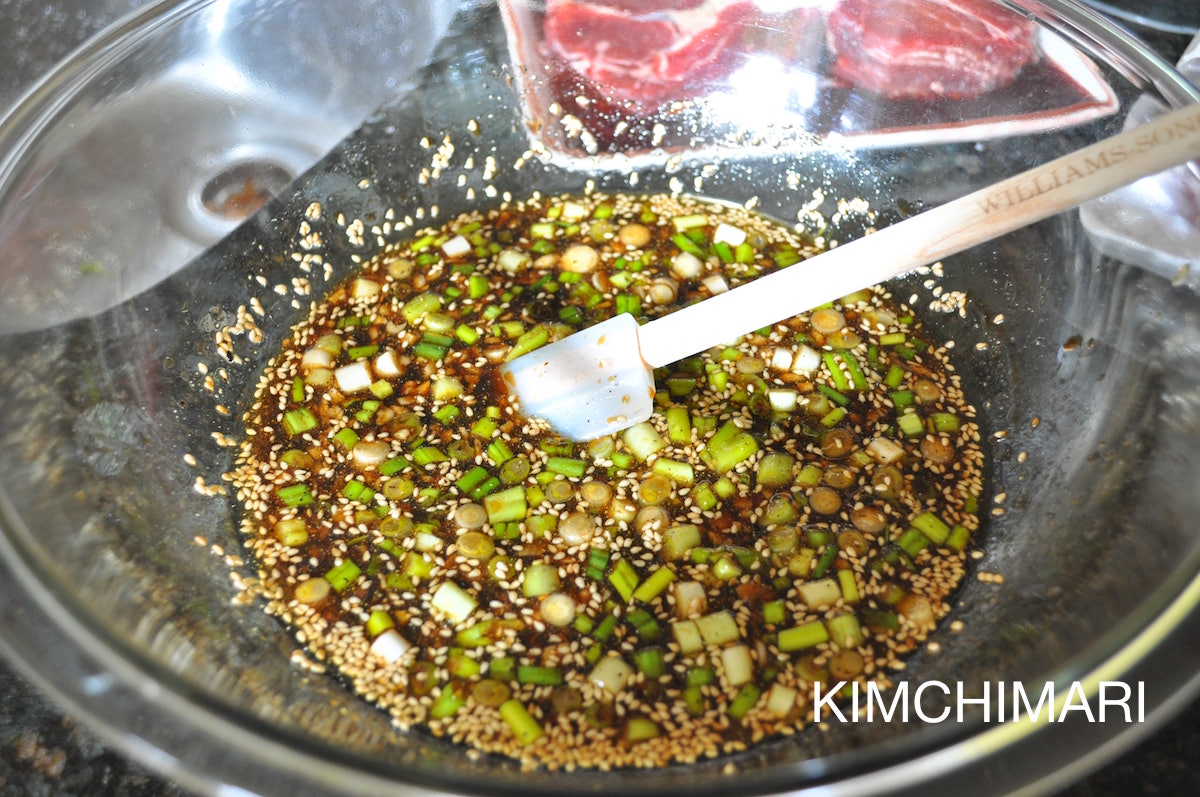
My favorite tenderizer to use is kiwi unless I have Asian pear at home (which I don't always). I know it's not traditional since kiwi is not a native Korean fruit but it really makes the meat melt in your mouth and much easier to buy outside of Korean groceries. Be careful not to use too much as it can actually make the beef almost crumble into nothing in your mouth.

2. Mix in the bulgogi beef into the sauce prepared above – in a bowl big enough to hold the beef. Make sure the sauce is well mixed with the beef. You will need to use your hands here and just massage everything together.
Make Ahead – and leave in the fridge overnight. Or if you are short on time (as is always the case with me.. ), making it just a few hours ahead works fine too. Even just 30 min. works. I've done that many times and most people don't even seem to notice the difference. 🙂 But of course, it will taste better if you give it time to marinate and absorb all that good flavor.
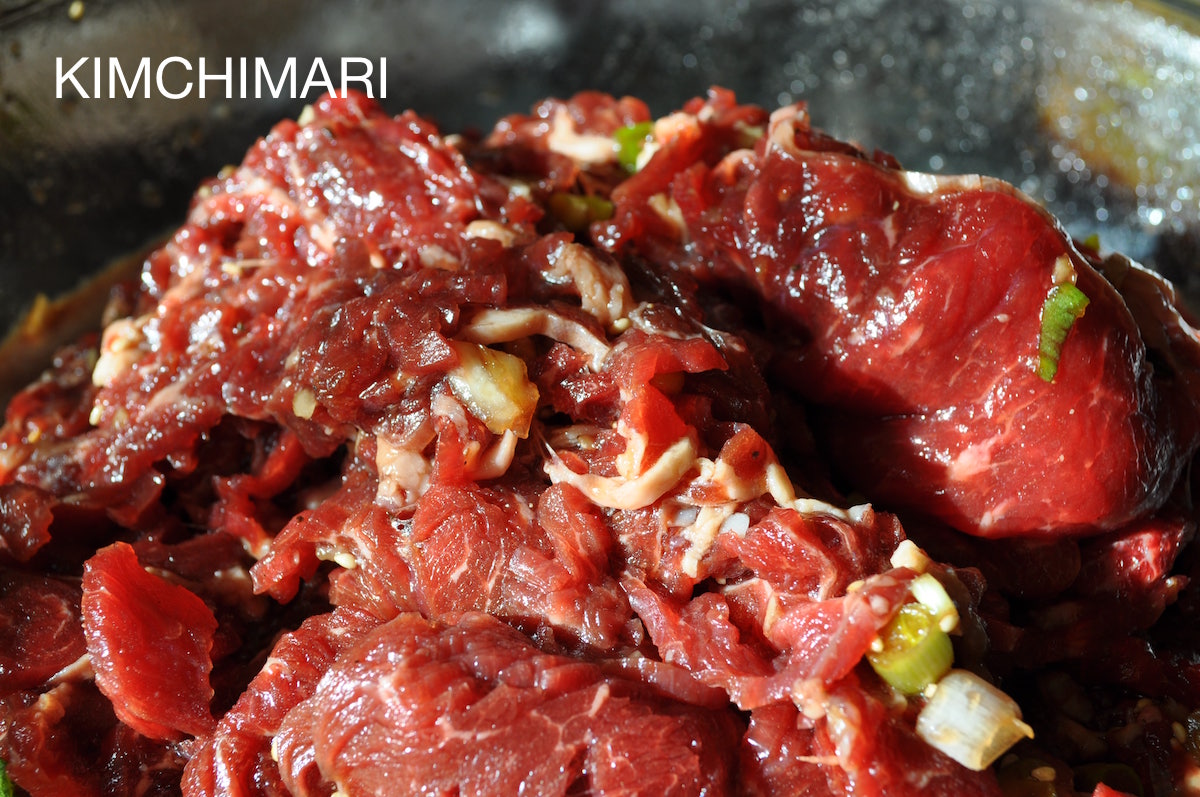
3. COOK YOUR MEAT – (watch video too)
- STOVE TOP – Heat up your favorite frying pan on MEDIUM-HIGH heat and just pan fry/stir fry the meat until it's slightly brown on both sides. Your pan should be hot enough so that the meat sizzles as it touches the pan. DON'T put too much meat into the pan and you will end up with a lot of the meat juice leaking out of the bulgogi which I personally don't think is good. But some like a lot of juice so your choice. Add your sliced vegetables to the pan about a minute after you start cooking the meat. Cook until meat is well cooked and caramelized (like you see below).
- OTHER – check my Tips above for other ways to cook.
And there you go!

NEW!! Watch and listen to my How to make Bulgogi video! Subscribe to my Youtube channel if you enjoyed it. 💕
How to make Bulgogi (Korean BBQ Beef)
If you have tried this recipe then please rate the recipe (☆☆☆☆☆ at the top right of the recipe card) and leave me a comment to let me know how you like it! 😍
You can alsoFOLLOW ME on FACEBOOK, PINTEREST and INSTAGRAM or join myFACEBOOK GROUP to ask and share everything about Korean food with others just like you! And also SUBSCRIBE to my Youtube Channel by watching the video and clicking on my logo on the right bottom of the screen.
XOXO ❤️
JinJoo
Prep: 20 minutes
Cook: 20 minutes
Total Time: 40 minutes
serves: 4
- 1 lb Thinly sliced sirloin (top sirloin or any tender loin area)
Marinade
- 3 Tbsp soy sauce
- 2 Tbsp light brown sugar [white sugar ok]
- 1 Tbsp honey [ 2 t sugar is also ok ]
- 2 Tbsp rice cooking wine or red wine [mirin works too]
- 1 Tbsp sesame oil
- 2 Tbsp minced garlic
- 1 tsp ground black pepper
- 2 tsp toasted sesame seeds
- 1 Tbsp chopped green onion
- 2 Tbsp pear, puree [ or 1 Tbs kiwi or 3 Tbs onion puree]
-
Make sauce by mixing all of the marinade ingredients together except for any optional vegetables such as onions or mushrooms.
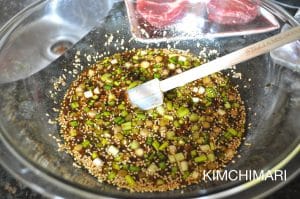
-
Mix in the bulgogi beef into the sauce prepared above – in a bowl big enough to hold the beef. Make sure the sauce is well mixed with the beef. You will need to use your hands here and just massage everything together.
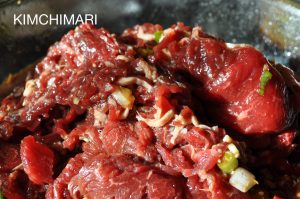
-
Heat up your favorite frying pan on high heat and just pan fry/stir fry the meat until it's slightly brown on both sides.
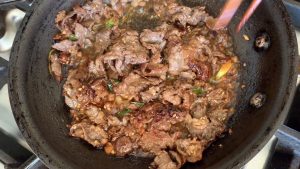
- Marinating - marinate minimum 30 min at room temp (not too hot) or in the fridge for several hours up to 24 hrs. Freeze if you need it later than 24 hrs.
- kiwi substitute - 2 Tbs pear puree can be substituted with 1 Tbs kiwi.
- Pan should be hot enough so that the meat sizzles as it touches the pan. Also, if you put too much meat into the pan and/or the heat is too low, you will end up with a lot of the meat juice leaking out of the bulgogi and you end up with Bulgogi stew.
- The most authentic and traditional way to cook Bulgogi ( Korean Beef BBQ ) is on top of a charcoal grill- you will either need a fine steel mesh or tin foil to cook the meat because otherwise it will fall through. Bulgogi is supposed to be well cooked and tastes great if it's a little burnt…
- You can also broil it on the top rack of your oven (Broil temp) but remember to keep a very close watch so it does not burn!
- Optional veggie ingredients - traditionally, Koreans just make bulgogi with beef by itself but if you are cooking it in a frying pan, you can add some sliced onions, mushrooms (shitake, white, oyster), bell peppers and even sliced carrots and cook them together.
Calories: 249 kcal (12%) | Carbohydrates: 13 g (4%) | Protein: 26 g (52%) | Fat: 8 g (12%) | Saturated Fat: 2 g (13%) | Cholesterol: 66 mg (22%) | Sodium: 747 mg (32%) | Potassium: 420 mg (12%) | Sugar: 12 g (13%) | Vitamin A: 15 IU | Vitamin C: 1.8 mg (2%) | Calcium: 42 mg (4%) | Iron: 2.1 mg (12%)
Source: https://kimchimari.com/bulgogi-korean-beef-bbq/

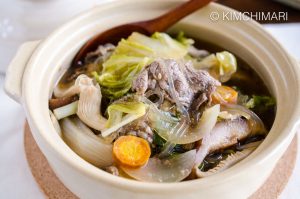
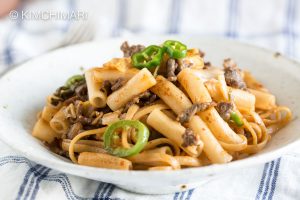
0 Response to "What Meat Used for Beef Bulgogi"
Post a Comment